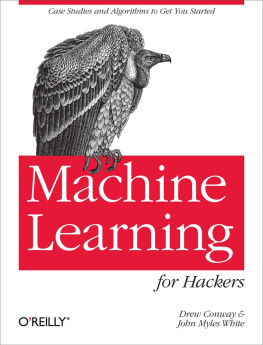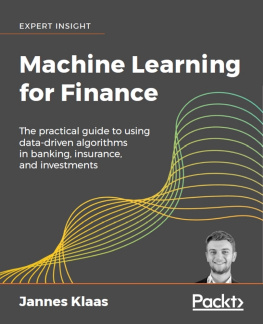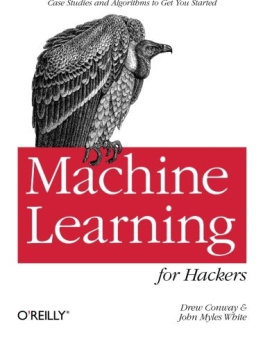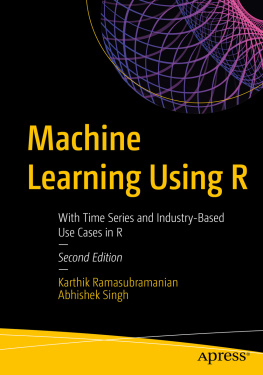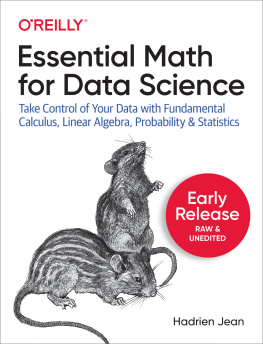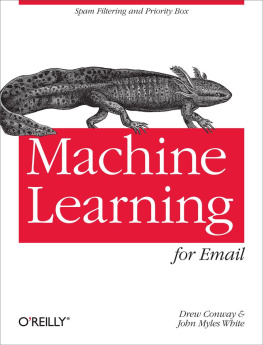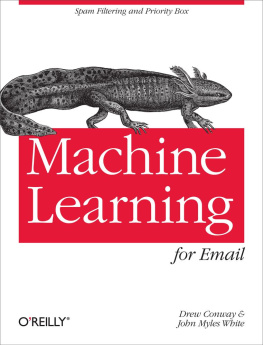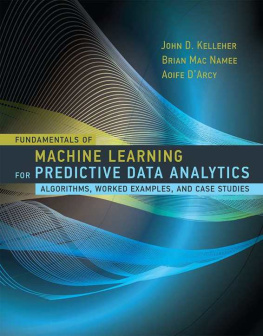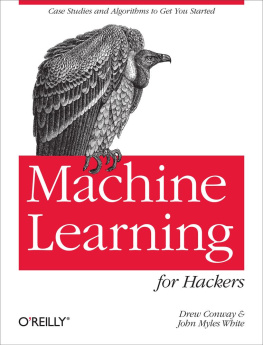To explain the perspective from which this book was written, it will be helpful to define the terms machine learning and hackers .
What is machine learning? At the highest level of abstraction, we can think of machine learning as a set of tools and methods that attempt to infer patterns and extract insight from a record of the observable world. For example, if we are trying to teach a computer to recognize the zip codes written on the fronts of envelopes, our data may consist of photographs of the envelopes along with a record of the zip code that each envelope was addressed to. That is, within some context we can take a record of the actions of our subjects, learn from this record, and then create a model of these activities that will inform our understanding of this context going forward. In practice, this requires data, and in contemporary applications this often means a lot of data (perhaps several terabytes). Most machine learning techniques take the availability of such data as given, which means new opportunities for their application in light of the quantities of data that are produced as a product of running modern companies.
What is a hacker? Far from the stylized depictions of nefarious teenagers or Gibsonian cyber-punks portrayed in pop culture, we believe a hacker is someone who likes to solve problems and experiment with new technologies. If youve ever sat down with the latest OReilly book on a new computer language and knuckled out code until you were well past Hello, World, then youre a hacker. Or if youve dismantled a new gadget until you understood the entire machinerys architecture, then we probably mean you, too. These pursuits are often undertaken for no other reason than to have gone through the process and gained some knowledge about the how and the why of an unknown technology.
Along with an innate curiosity for how things work and a desire to build, a computer hacker (as opposed to a car hacker, life hacker, food hacker, etc.) has experience with software design and development. This is someone who has written programs before, likely in many different languages. To a hacker, Unix is not a four-letter word, and command-line navigation and bash operations may come as naturally as working with GUIs. Using regular expressions and tools such as sed, awk, and grep are a hackers first line of defense when dealing with text. In the chapters contained in this book, we will assume a relatively high level of this sort of knowledge.
How This Book Is Organized
Machine] But another important part of the hacker mantra is to learn by doing. Many hackers may be more comfortable thinking of problems in terms of the process by which a solution is attained, rather than the theoretical foundation from which the solution is derived.
From this perspective, an alternative approach to teaching machine learning would be to use cookbook-style examples. To understand how a recommendation system works, for example, we might provide sample training data and a version of the model, and show how the latter uses the former. There are many useful texts of this kind as well, and Segarans Programming Collective Intelligence is one recent example . Such a discussion would certainly address the how of a hackers method of learning, but perhaps less of the why . Along with understanding the mechanics of a method, we may also want to learn why it is used in a certain context or to address a specific problem.
To provide a more complete reference on machine learning for hackers, therefore, we need to compromise between providing a deep review of the theoretical foundations of the discipline and a broad exploration of its applications. To accomplish this, we have decided to teach machine learning through selected case studies.
We believe the best way to learn is by first having a problem in mind, then focusing on learning the tools used to solve that problem. This is effectively the mechanism through which case studies work. The difference being, rather than having some problem for which there may be no known solution, we can focus on well-understood and studied problems in machine learning and present specific examples of cases where some solutions excelled while others failed spectacularly.
For that reason, each chapter of this book is a self-contained case study focusing on a specific problem in machine learning. The organization of the early cases moves from classification to regression (discussed further in ). We then examine topics such as clustering, dimensionality reduction, and optimization. It is important to note that not all problems fit neatly into either the classification or regression categories, and some of the case studies reviewed in this book will include aspects of both (sometimes explicitly, but also in more subtle ways that we will review). Following are brief descriptions of all the case studies reviewed in this book in the order they appear:
Text classification: spam detection
In this chapter we introduce the idea of binary classification, which is motivated through the use of email text data. Here we tackle the classic problem in machine learning of classifying some input as one of two types, which in this case is either ham (legitimate email) or spam (unwanted email).
Ranking items: priority inbox
Using the same email text data as in the previous case study, here we move beyond a binary classification to a discrete set of types. Specifically, we need to identify the appropriate features to extract from the email that can best inform its priority rank among all emails.
Regression models: predicting page viewsWe now introduce the second primary tool in machine learning, linear regression. Here we explore data whose relationship roughly approximates a straight line. In this case study, we are interested in predicting the number of page views for the top 1,000 websites on the Internet as of 2011.
Regularization: text regression
Sometimes the relationships in our data are not well described by a straight line. To describe the relationship, we may need to fit a different function; however, we also must be cautious not to overfit. Here we introduce the concept of regularization to overcome this problem, and motivate it through a case study, focusing on understanding the relationship among words in the text from OReilly book descriptions.
Optimization: code breaking
Moving beyond regression models, almost every algorithm in machine learning can be viewed as an optimization problem in which we try to minimize some measure of prediction error. Here we introduce classic algorithms for performing this optimization and attempt to break a simple letter cipher with these techniques.
Unsupervised learned: building a stock market index
Up to this point we have discussed only supervised learning techniques. Here we introduce its methodological counterpart: unsupervised learning. The important difference is that in supervised learning, we wish to use the structure of our data to make predictions, whereas in unsupervised learning, we wish to discover structure in our data for structures sake. In this case we will use stock market data to create an index that describes how well the overall market is doing.

